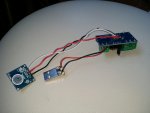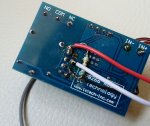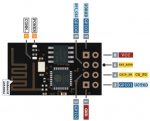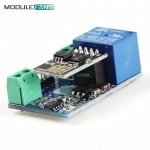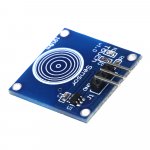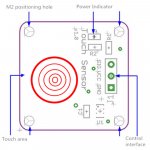// Relay control using the ESP8266 WiFi chip
// Import required libraries
#include <ESP8266WiFi.h>
// WiFi parameters
const char* ssid = "******";
const char* password = "*****";
//Room Name
//Response from Client
String request = "";
// The port to listen for incoming TCP connections
#define LISTEN_PORT 80
// set pin numbers:
const int buttonPin = 0; // the number of the pushbutton pin
const int relayPin = 2; // the number of the LED pin
int relayState = LOW; // the current state of the output pin
int buttonState; // the current reading from the input pin
int lastButtonState = LOW; // the previous reading from the input pin
long lastDebounceTime = 0; // the last time the output pin was toggled
long debounceDelay = 50; // the debounce time; increase if the output flickers
// Create an instance of the server
WiFiServer server(LISTEN_PORT);
WiFiClient client;
void setup(void)
{
// Start Serial
Serial.begin(115200);
delay(10);
Serial.println();
Serial.println();
Serial.println();
Serial.println();
pinMode(buttonPin, INPUT);
pinMode(relayPin, OUTPUT);
// set initial LED state
digitalWrite(relayPin, relayState);
// Connect to WiFi
WiFi.begin(ssid, password);
while (WiFi.status() != WL_CONNECTED) {
delay(500);
Serial.print(".");
}
Serial.println("");
Serial.println("WiFi connected");
// Start the server
server.begin();
Serial.println("Server started");
Serial.println("You can connect to this Switch at this URL:");
Serial.print("http://");
// Print the IP address
Serial.print(WiFi.localIP());
Serial.println("/");
}
void loop() {
String request = "";
// Handle REST calls
WiFiClient client = server.available();
if (client) {
Serial.println("User connected.");
while(!client.available()){
delay(1);
}
Serial.print("Request Received:");
String request = client.readStringUntil('\r\n');
Serial.println(request);
client.flush();
}
//process the request
if (request.indexOf("/LED=ON") != -1) {
digitalWrite(relayPin,LOW);
relayState = HIGH;
}
if (request.indexOf("/LED=OFF") != -1) {
digitalWrite(relayPin,HIGH);
relayState = LOW;
}
// read the state of the switch into a local variable:
int reading = digitalRead(buttonPin);
// If the switch changed, due to noise or pressing:
if (reading != lastButtonState) {
// reset the debouncing timer
lastDebounceTime = millis();
}
if ((millis() - lastDebounceTime) > debounceDelay) {
// whatever the reading is at, it's been there for longer
// than the debounce delay, so take it as the actual current state:
// if the button state has changed:
if (reading != buttonState) {
buttonState = reading;
// only toggle the LED if the new button state is HIGH
if (buttonState == HIGH) {
relayState = !relayState;
}
}
}
digitalWrite(relayPin, relayState);
// save the reading. Next time through the loop,
// it'll be the lastButtonState:
lastButtonState = reading;
if (client) {
client.println("HTTP/1.1 200 OK");
client.println("Content-Type: text/html");
client.println("");
client.println("<!DOCTYPE HTML>");
client.println("<html>");
client.println("<head><title>ESP8266 RELAY Control</title></head>");
client.print("<h1>Relay is now: </h1>");
if(relayState == HIGH)
{
client.print("<div style=\"text-align: center;width: 198px;color:white ;padding: 10px 30px;background-color: #ff9900;margin: 0 auto;\">OFF</div>");
}
else
{
client.print("<div style=\"text-align: center;width: 198px;color:white ;padding: 10px 30px;background-color: #43a209;margin: 0 auto;\">ON</div>");
}
client.println("<br><br>");
client.println("<div>");
client.println("<div style=\"text-align: center;font-size: 50px;width: 298px;color:white ;padding: 10px 30px;background-color: #ff9900;margin: 0 auto;\">Turn <a href=\"/LED=OFF\">OFF</a> RELAY<br></div>");
client.println("<div style=\"text-align: center;font-size: 50px;width: 298px;color:white ;padding: 10px 30px;background-color: #43a209;margin: 0 auto;\">Turn <a href=\"/LED=ON\">ON</a> RELAY<br></div>");
client.println("</div>");
client.println("</html>");
delay(1);
Serial.println("Client disonnected");
Serial.println("");
}
}

